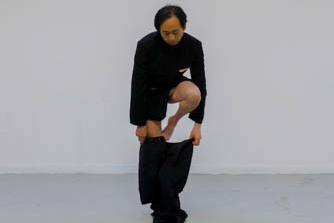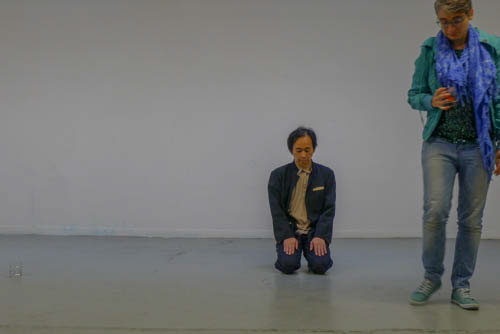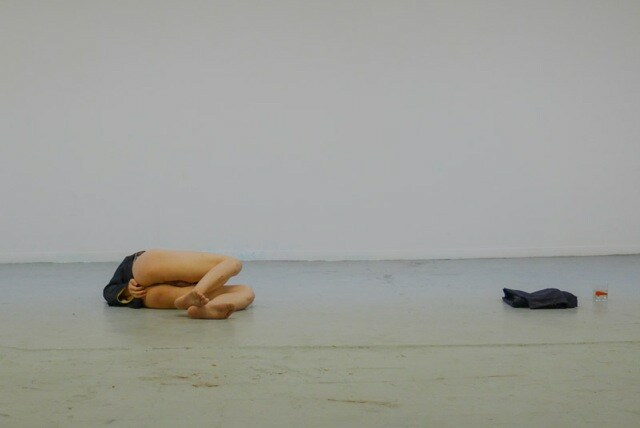Standing man
(2017)’30
Philemon Mukarno
Standing Man Nude Spirituality: Philemon Mukarno’s Transcendent Ritual at PAS #55 DUEL
At PAS #55 ‘DUEL’, Philemon Mukarno’s Standing Man redefined nudity as sacred ritual. PAS, founded by BBB Johannes Deimling, champions performance rooted in the visual art tradition. Mukarno’s work is not simply spectacle—it’s a somatic investigation where primal tension confronts form. The DUEL theme underscores a fierce interplay: artistic control against ancient spiritual chaos. Mukarno’s ritual aligns with PAS’s vision of communal research, knowledge exchange, and artistic experience that echo deeply within the audience.
The Sacred Performance Site: Where Vulnerability Becomes Sanctuary
Presented in collaboration with P.S. Performance Site, Standing Man unfolds in a contemporary sanctuary for radical art. This historically charged space has always dismantled artistic boundaries. Mukarno’s nude performance is both a spiritual offering and a bold confrontation. His nakedness becomes a gesture of personal and social transformation. Here, vulnerability and honesty are reclaimed as sources of power and discourse. The performance’s context elevates each movement, layering spiritual meaning upon artistic legacy.
Philemon Mukarno: From Ritual to Avant-Garde
Mukarno’s journey bridges Asian spiritual heritage with European avant-garde. Born in Jakarta and based in Rotterdam, he draws from traditions at Codarts, blending music composition and Japanese Butoh. This synthesis forges new dialogue—marrying Butoh’s physical discipline to ritualistic stillness. In Standing Man, Mukarno’s body becomes the expressive core, communicating universal longing for transcendence and freedom.
Body as Sacred Microcosm: Nude as Radical Honesty
For Mukarno, nudity is not spectacle but deep somatic research. Exposing the body is radical honesty, an invitation to spiritual repair. The performer’s skin becomes landscape—vulnerable, layered with ancestral and environmental truths. This sacred microcosm challenges self-images shaped by culture. It returns the viewer to a primal state, asking for authentic connection. Mukarno’s philosophy breathes through every gesture and stillness, transforming public exposure into profound strength.
The Shadowbody: Navigating Vulnerability and Inner Chaos
Mukarno’s aesthetic refuses purity, embracing the body’s shadow—its subconscious struggles. As Standing Man remains motionless, the figure holds both light and darkness within. Physical discomfort mirrors existential challenge. This duel with the “Shadowbody” is not just a metaphor, but a lived process of spiritual encounter. The body is both a container and a stage for conflict with unseen forces.
Butoh Techniques: Zero State and Controlled Transformation
Butoh technique infuses Standing Man with intense rigor. The stillness is not passive: it’s the “zero state”—active, mental concentration resisting movement. Somatic mastery creates physical tension that deepens spiritual aim. Mukarno’s nude vulnerability heightens each second, transforming simplicity into extraordinary performance.
Elemental Alchemy: The Duel of Water, Blood, and Flesh
In staging, Mukarno stands nude on a white cloth, touching a shallow pool. Water and blood merge onstage, blurring the boundary between purity and sacrifice. Mist, light, and movement conjure primal elements. Blood—painted and released—creates vivid, living veins on the body and glass. These gestures evoke ancestral memory, transformative rivers, and spiritual cost. The scene’s elemental configuration evokes axis mundi—a ritual space joining earth, water, and spiritual intentions.
Interacting with Living Symbols: The Golden Fish
Golden fish swim in nearby glass bowls, their movements unpredictable and mysterious. As blood touches water, the fish respond, forming transient shapes. Audiences engage using plexiglass, casting magical shadows. The organic presence of the fish contrasts with the human body’s controlled stillness, inviting awe and involvement. These living beings serve as innocent witnesses to human vulnerability and transformation.
Glass, Reflection, and Audience Ritual
Glass vessels both contain and reflect the ritual’s intensity. Patterns painted on glass echo the body’s journey. Through participatory interaction—casting light, shadow, and forms—spectators become essential collaborators. Each reflection is communal magic, breaking isolation and deepening the theatre of vulnerability.
Climax: Ritual Release and Permanent Transformation
After long stillness, Mukarno’s body explodes into motion. Arms spread, sacred objects—fish-shaped amulets, bloodied and blessed—are dropped into the pool. Music surges, blending underwater tones and primal rhythm. Water and blood merge on the cloth, leaving permanent patterns. These shapes capture movement, memory, and transformation. Upon departure, the audience encounters not absence, but sacred presence memorialized in blood, water, and myth.
Conclusion: Standing Man as a Model of Spiritual Performance Art
Standing Man is a poetic ritual of nude vulnerability, transformation, and artistic truth. Mukarno utilizes ancestral wisdom, the intensity of Butoh, and academic depth to redefine performance art. His DUEL—the tension between body, mind, and the elements—remains as real as the stains upon the sacred canvas. Audiences leave marked by the ritual, bearing a spiritual connection with the body, the earth, and the poetic art of transcendence. Mukarno’s cartography of consciousness finds new expression in the standing human form—raw, honest, and eternally changing.








